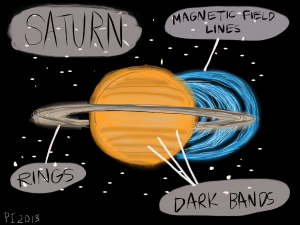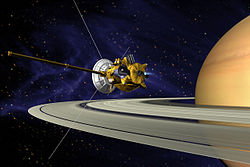 The latest in our paper discussions took us away from our usual territory- and out to Saturn. Cao et al’s paper Saturn’s high degree magnetic moments: Evidence for a unique planetary dynamo looks at modelling the magnetic field of Saturn, which is very different to the field of the Earth. Parts of the magnetic field have been measured by Pioneer 11, and both Voyager missions, and more recently, Saturn has been visited by the Cassini mission, which also recorded magnetic data, and essentially confirmed what was already known. Analysis of the data from Pioneer and Voyager(s) and modelling of low spherical harmonic degrees (g01, g02 and g03) show Saturn’s field to be highly axisymmetric (i.e. symmetrical around the spin axis, with little difference as you move along the equator but poles of opposite sign) and also much weaker than the field of the Earth, being around 30,000nT at the surface, compared to 50,000nT here. The field axis is the same as the rotational axis, to within 0.06o. There has also been very little change in the field measured between the Voyager missions and Cassini’s arrival. The magnetic moments of the lower spherical harmonic degrees having being well modelled with the available data, in this paper the authors try to model higher degrees, g04 and g05 with the new data from Cassini.
The latest in our paper discussions took us away from our usual territory- and out to Saturn. Cao et al’s paper Saturn’s high degree magnetic moments: Evidence for a unique planetary dynamo looks at modelling the magnetic field of Saturn, which is very different to the field of the Earth. Parts of the magnetic field have been measured by Pioneer 11, and both Voyager missions, and more recently, Saturn has been visited by the Cassini mission, which also recorded magnetic data, and essentially confirmed what was already known. Analysis of the data from Pioneer and Voyager(s) and modelling of low spherical harmonic degrees (g01, g02 and g03) show Saturn’s field to be highly axisymmetric (i.e. symmetrical around the spin axis, with little difference as you move along the equator but poles of opposite sign) and also much weaker than the field of the Earth, being around 30,000nT at the surface, compared to 50,000nT here. The field axis is the same as the rotational axis, to within 0.06o. There has also been very little change in the field measured between the Voyager missions and Cassini’s arrival. The magnetic moments of the lower spherical harmonic degrees having being well modelled with the available data, in this paper the authors try to model higher degrees, g04 and g05 with the new data from Cassini.
The results they find agree with what was previously found – that Saturn’s field is highly axisymmetric, with most of the magnetic flux confined to polar regions, and higher degrees of the field are relatively small contributions to the overall measured field – hence not being seen on some more distant orbits of the satellite. They also suggest a similarity to certain types of dynamo models – such as spherical Couette dynamos, where the dynamo is driven by differential rotation between outer and inner layers of a shell. This is a very different type of dynamo to the Earth, with its convection driven dynamo – and indeed may not even be physically possible for Saturn! In this case, the different rotations could be due to a transition in the phase of helium (such as the gaseous atmosphere ‘raining’ liquid helium at pressure), a metallic layer, or the solid core of the planet. This was certainly the part of the paper that provoked most discussion amongst us – and several sci-fi type visualisations of what helium rain might look like!
Cao, H, Russell, C, Wicht, J, Christensen, U, and Dougherty, M. Icarus 221, 2012, 388–394: Saturn’s high degree magnetic moments: Evidence for a unique planetary dynamo.
 Today’s post was guest written by Kelly Barker. Kelly is a PhD student in the geomagnetism research group at the Department of Earth, Ocean and Ecological Sciences at the Univeristy of Liverpool. Her research project is entitled: Improved application of remote referencing data in aeromagnetic processing: insights and applications from global geomagnetic modelling.
Today’s post was guest written by Kelly Barker. Kelly is a PhD student in the geomagnetism research group at the Department of Earth, Ocean and Ecological Sciences at the Univeristy of Liverpool. Her research project is entitled: Improved application of remote referencing data in aeromagnetic processing: insights and applications from global geomagnetic modelling.


Leave a Reply to Anonymous Cancel reply